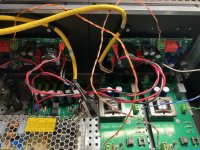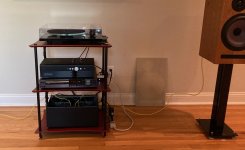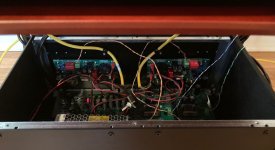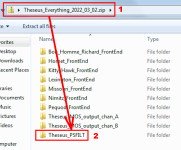Hi
I don't have the boards yet and before committing to the build, i am reading what is available, between manual and forums.
I haven't done electronics in a while and most of it was most theoretical (lots of calculations, little practice to understand the usefullness of the circuit...school!)
That being said, that's now a great way to learn another way, more practical, with music to enjoy at the end (hopefully!)
Given your pointer and the fact that one of the working channel of ranshdow is 13.5V, i went back to the PSFilt schematic.
If Supply_V+ is 36V and Ch1_V+ is the supply for 1 of the channel, then Supply_V+ = Ch1_V+ (red) + Tension across {resistor+bead+resistor & coil} (yellow).
Ch1_V+ is then inferior to Supply_V+ (36v).
If that's the right understanding, i could proceed to the calculation (if i still know how to do)
If not, then
 and that would explain my not so good grades @school! (electricity was not my forte!)
and that would explain my not so good grades @school! (electricity was not my forte!)
In any case, have a nice day and thanks for the puzzle...
I don't have the boards yet and before committing to the build, i am reading what is available, between manual and forums.
I haven't done electronics in a while and most of it was most theoretical (lots of calculations, little practice to understand the usefullness of the circuit...school!)
That being said, that's now a great way to learn another way, more practical, with music to enjoy at the end (hopefully!)
Given your pointer and the fact that one of the working channel of ranshdow is 13.5V, i went back to the PSFilt schematic.
If Supply_V+ is 36V and Ch1_V+ is the supply for 1 of the channel, then Supply_V+ = Ch1_V+ (red) + Tension across {resistor+bead+resistor & coil} (yellow).
Ch1_V+ is then inferior to Supply_V+ (36v).
If that's the right understanding, i could proceed to the calculation (if i still know how to do)
If not, then
In any case, have a nice day and thanks for the puzzle...
Attachments
I'm using a power supply filter different from the one Mark designed that appears to drop about 2V relative to the output of the Meanwell SMPS.Given your pointer and the fact that one of the working channel of ranshdow is 13.5V, i went back to the PSFilt schematic.
I am gathering components to build a Lexington Front end for my Sony VFET amp. I have been able to source everything but the ZTX857 NPN bipolar xitor….Part # on the build sheet is 552-ZTX857STZ. The soonest that I can possibly get one seems to be Oct 2023. Is there a substitute that I can use? Or another supplier? I have tried Mouser, Digi-Key and E-Bay with no luck finding one in stock. Any one have two in a drawer that they would be willing to sell?
Keith
Keith
This Ship has Sailed
So, replacing Q3 on channel A of my THESEUS-MOS output stage did the trick, and I was now able to set source bias on Q5 of half of filtered rail, 16.95V against 33.9V. I let this build sit awhile while life took over, but today I finished the speaker wiring using repurposed ethernet cable & powered it up. This build uses PEQUOD front ends with Analog Devices LT1122 single "fast settling" op-amps, one per channel, per Mark's note on the schematic, and 8.32k ohms of resistance in the feedback loop.
It made good music in the garage, albeit with a bit of a kick to the speakers on power up. I let it run for a half hour & measured some temperatures with a thermocouple. Q4 gets pretty hot, ~57C on channel B and 63C on channel A, while Q1 got to 43C and 46C, respectively. Don't know what to make of this if anything, but it seems like channel A's Q4 might fail early. Q3, the part which had previously failed on channel A, was at 56C for channel A and 54C for channel B. I measured the power MOSFETs at their mounting bolts, they were all a very reasonable 41C to 45C with their heat sinks fully warm to the touch.
I liked the sound on little Fostex full rangers in folded horns, so I got brave despite the speaker kick & put this Ship in my main system. Compared to the lottery P-ch SONY VFET amp I've been running, my initial impression of the sound was that it's a touch fuller and cleaner with lots of imaging and detail. However it seems to get a bit congested on more complex material sourced from an antique CD player, and when streaming JAZZ 24 from a modern source, I had trouble getting the volume dialed in right- with more extended listening, the loudness profile seems different from the P-channel SONY VFET amp, maybe missing some midrange and midbass fullness. But it sounds goood to me, detailed and forward, and I'm listening to it now from the next room & the rest of the evening. I'll probably listen to this a while before I start tweaking. I've got a pair of OPA2134s waiting in the garage.
One thing in the back of my mind has been to build a linear power supply in a separate enclosure that could deliver either 24V or 36V. The Sony VFET lottery and this Ship of Theseus would take 36V, while an ACA and ACA mini would take 24V, so there's lots of amps for me to play with. There doesn't seem to be an easy way to switch between the two using the secondaries of a single power toroid, e.g. 24V vs 48V, or 36V vs 72V, so we'll see.
So, replacing Q3 on channel A of my THESEUS-MOS output stage did the trick, and I was now able to set source bias on Q5 of half of filtered rail, 16.95V against 33.9V. I let this build sit awhile while life took over, but today I finished the speaker wiring using repurposed ethernet cable & powered it up. This build uses PEQUOD front ends with Analog Devices LT1122 single "fast settling" op-amps, one per channel, per Mark's note on the schematic, and 8.32k ohms of resistance in the feedback loop.
It made good music in the garage, albeit with a bit of a kick to the speakers on power up. I let it run for a half hour & measured some temperatures with a thermocouple. Q4 gets pretty hot, ~57C on channel B and 63C on channel A, while Q1 got to 43C and 46C, respectively. Don't know what to make of this if anything, but it seems like channel A's Q4 might fail early. Q3, the part which had previously failed on channel A, was at 56C for channel A and 54C for channel B. I measured the power MOSFETs at their mounting bolts, they were all a very reasonable 41C to 45C with their heat sinks fully warm to the touch.
I liked the sound on little Fostex full rangers in folded horns, so I got brave despite the speaker kick & put this Ship in my main system. Compared to the lottery P-ch SONY VFET amp I've been running, my initial impression of the sound was that it's a touch fuller and cleaner with lots of imaging and detail. However it seems to get a bit congested on more complex material sourced from an antique CD player, and when streaming JAZZ 24 from a modern source, I had trouble getting the volume dialed in right- with more extended listening, the loudness profile seems different from the P-channel SONY VFET amp, maybe missing some midrange and midbass fullness. But it sounds goood to me, detailed and forward, and I'm listening to it now from the next room & the rest of the evening. I'll probably listen to this a while before I start tweaking. I've got a pair of OPA2134s waiting in the garage.
One thing in the back of my mind has been to build a linear power supply in a separate enclosure that could deliver either 24V or 36V. The Sony VFET lottery and this Ship of Theseus would take 36V, while an ACA and ACA mini would take 24V, so there's lots of amps for me to play with. There doesn't seem to be an easy way to switch between the two using the secondaries of a single power toroid, e.g. 24V vs 48V, or 36V vs 72V, so we'll see.
Attachments
If you're really scared about the case temperature of the TO-126 transistors, even after studying the power-vs-temp curves in the transistor datasheets,
you could affix a "field improvised heatsink" aka merde-rig heatsink. Drill a 3mm / (1/8 in) hole in a US 25 cent coin. Sand the rear face smooth, either with sandpaper, or a DMT diamond hone, until the zinc disappears, the copper appears, and the surface is nice and flat. Apply a thin layer of thermal paste (no insulator is needed) and bolt the heatsink to the rear of the TO-126. Now you've satisfied your overwhelming desire to "do something! Come on, DO SOMETHING!" about the scary transistor case temperature.
The good news is, this is inexpensive ($0.25) and copper is an excellent thermal conductor. The bad news is, you're defacing US currency which might trouble your conscience, perhaps.
(product link 1) , (product link 2) ,
you could affix a "field improvised heatsink" aka merde-rig heatsink. Drill a 3mm / (1/8 in) hole in a US 25 cent coin. Sand the rear face smooth, either with sandpaper, or a DMT diamond hone, until the zinc disappears, the copper appears, and the surface is nice and flat. Apply a thin layer of thermal paste (no insulator is needed) and bolt the heatsink to the rear of the TO-126. Now you've satisfied your overwhelming desire to "do something! Come on, DO SOMETHING!" about the scary transistor case temperature.
The good news is, this is inexpensive ($0.25) and copper is an excellent thermal conductor. The bad news is, you're defacing US currency which might trouble your conscience, perhaps.
(product link 1) , (product link 2) ,
- Home
- Amplifiers
- Pass Labs
- Ship Of Theseus: compatible, interchangeable amplifier modules










